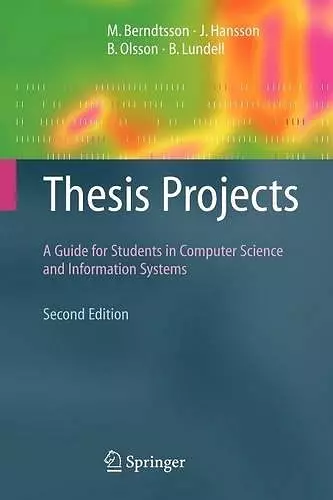Thesis Projects
A Guide for Students in Computer Science and Information Systems
Mikael Berndtsson author Jörgen Hansson author B Olsson author Björn Lundell author
Format:Paperback
Publisher:Springer London Ltd
Published:25th Oct '07
Currently unavailable, and unfortunately no date known when it will be back

You’re a computing or information student with a huge mountain to climb – that final-year research project. Don’t worry, because with this book guardian angels are at hand, in the form of four brilliant academics who will guide you through the process. The book provides you with all the tools necessary to successfully complete a final year research project. Based on an approach that has been tried and tested on over 500 projects, it offers a simple step-by-step guide to the key processes involved. Not only that, but the book also contains lots of useful information for supervisors and examiners including guidelines on how to review a final year project.
From the reviews:
"The authors have written a short book for students doing final year projects in computer science and information systems. Because the authors are from Sweden, the details of the procedures and expectations will vary in other countries. However, in the hands of a discerning reader, this book could be useful at several levels, at many colleges and universities, and in many countries.
The first section of the book introduces general concepts related to final year projects. Chapter 2 describes research and research methods in computer science and information systems. Chapter 3 discusses the roles of the student, the supervisor, and the examiner. Chapter 4 provides a very brief overview of the process of conducting final year projects.
The second and most extensive section of the book describes chronologically the major steps in the project. Chapter 5 describes the process of choosing a subject and developing a formal proposal. Chapter 6 explains how to handle references in the literature search. Chapter 7 describes the process of narrowing the aim of the project. Chapter 8 covers developing project objectives and choosing methods. Chapter 9 briefly discusses following, or not following, the project objectives. Chapter 10 takes a careful look at presenting and analyzing the data. Chapter 11 discusses drawing your conclusions, evaluating your work, and identifying future work. Finally, chapter 12 discusses the oral defense.
The third section of the book consists of a set of supplementary chapters. Chapter 13 discusses the report itself, including both general writing style and specific citation styles. Chapter 14 turns the tables and examines the examiner’s role. The book also includes a bibliography, a list of things not to do, and a list of relevant bibliographies available on the Internet.
According to the authors, "The amount of time spent reading a particular source is not relevant to whether it should be discussed in your analysis.” The authors provide many such useful suggestions, which, although obvious, might be forgotten in the rush to write. They suggest studying a journal article in the subject area to examine the typical structure of a research report. They also suggest writing the abstract last. In addition, they suggest identifying both good and poor decisions made during the research process. They also point out this useful piece of advice: "You can usually get away with being boring, if what you say is well-organized and clear; but you cannot get away with talking nonsense just by being entertaining.”
About the conclusions of the project report, the authors say, "This is not the time or place to surprise the enthusiastic reader (this is a technical report, and not a novel where the least suspected person is found to be the murderer at the end).” Similarly, this book has no surprises, just well organized, clear, and useful advice."
by Ann Fleury from Aurora University, Illinois USA.
ACM Computing Reviews, December 2002
"The authors have written a short book for students doing final year projects in computer science and information systems. … According to the authors, ‘the amount of time spent reading a particular source is not relevant to whether it should be discussed in your analysis.’ The authors provide many such useful suggestions … . this book has … just well organized, clear and useful advice." (Ann Fleury, ACM Computing Reviews, December, 2002)
ISBN: 9781848000087
Dimensions: unknown
Weight: 570g
162 pages
2nd ed. 2008